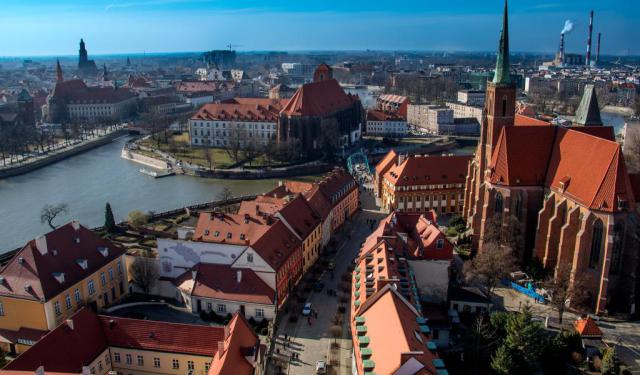
Pomnik Sw. Jana Nepomucena (Monument of St. John of Nepomuk), Wroclaw
John of Nepomuk, a revered saint, renowned for his role in safeguarding against the perils of floods, held particular importance in a city graced with an intricate network of waterways. Born in the 14th century in Pomuk (later renamed Nepomuk), was a Christian presbyter and the confessor of Queen Sophia of Bavaria. His life took a fateful turn when, as the keeper of royal confessions, he faced a perilous dilemma. Refusing to disclose the queen's secrets to her husband, Wenceslaus IV of Bohemia, John met a tragic end, cast into the unforgiving waters of the Vltava River.
The statue of John of Nepomuk that now stands proudly on Ostrów Tumski was meticulously crafted between 1730 and 1732. The skilled hands responsible for this masterpiece belonged to Bohemian-German sculptor Johann Georg Urbansky, who brought to life a design conceived by Christoph Tausch.
Upon closer inspection, one may notice a charming and somewhat peculiar detail on this monument. Two of the cherubs adorning the figure are depicted as bald, in contrast to the typical representation of cherubs with a full head of (presumably golden) curls. This whimsical touch carries an endearing story with it. It is said that Urbansky's assistant, tasked with sculpting the final cherub heads, was inspired by the arrival of his hairless newborn son. To commemorate this special occasion, he decided to immortalize his baby's likeness among the celestial choir of angels. Initially met with his boss's ire, the sculptor's audacious act eventually won over Urbansky's heart, prompting him to grant a second cherub a buzz cut to maintain symmetry.
The statue of John of Nepomuk that now stands proudly on Ostrów Tumski was meticulously crafted between 1730 and 1732. The skilled hands responsible for this masterpiece belonged to Bohemian-German sculptor Johann Georg Urbansky, who brought to life a design conceived by Christoph Tausch.
Upon closer inspection, one may notice a charming and somewhat peculiar detail on this monument. Two of the cherubs adorning the figure are depicted as bald, in contrast to the typical representation of cherubs with a full head of (presumably golden) curls. This whimsical touch carries an endearing story with it. It is said that Urbansky's assistant, tasked with sculpting the final cherub heads, was inspired by the arrival of his hairless newborn son. To commemorate this special occasion, he decided to immortalize his baby's likeness among the celestial choir of angels. Initially met with his boss's ire, the sculptor's audacious act eventually won over Urbansky's heart, prompting him to grant a second cherub a buzz cut to maintain symmetry.
Want to visit this sight? Check out these Self-Guided Walking Tours in Wroclaw. Alternatively, you can download the mobile app "GPSmyCity: Walks in 1K+ Cities" from Apple App Store or Google Play Store. The app turns your mobile device to a personal tour guide and it works offline, so no data plan is needed when traveling abroad.
Pomnik Sw. Jana Nepomucena (Monument of St. John of Nepomuk) on Map
Sight Name: Pomnik Sw. Jana Nepomucena (Monument of St. John of Nepomuk)
Sight Location: Wroclaw, Poland (See walking tours in Wroclaw)
Sight Type: Statue/Public Art
Guide(s) Containing This Sight:
Sight Location: Wroclaw, Poland (See walking tours in Wroclaw)
Sight Type: Statue/Public Art
Guide(s) Containing This Sight:
Walking Tours in Wroclaw, Poland
Create Your Own Walk in Wroclaw
Creating your own self-guided walk in Wroclaw is easy and fun. Choose the city attractions that you want to see and a walk route map will be created just for you. You can even set your hotel as the start point of the walk.
Wroclaw Introduction Walking Tour
Wroclaw, the capital of Poland’s Lower Silesia province, is a travel gem for wandering hearts. Steeped in over 1,000 years of history and a vibrant blend of Polish, German, and other cultural influences, it could easily compete for the title of the most beautiful city in Europe.
The area around Wroclaw was inhabited as early as the 9th century by Slavic tribes. The town was originally part of... view more
Tour Duration: 2 Hour(s)
Travel Distance: 3.7 Km or 2.3 Miles
The area around Wroclaw was inhabited as early as the 9th century by Slavic tribes. The town was originally part of... view more
Tour Duration: 2 Hour(s)
Travel Distance: 3.7 Km or 2.3 Miles
Cathedral Island Walking Tour
Cathedral Island, known as "Ostrów Tumski" in Polish, is a historic and enchanting district in the heart of Wroclaw. This picturesque island, nestled amid the Oder River, is a treasure trove of architectural and cultural wonders that date back centuries.
Begin your journey by crossing the iconic Tumski Bridge. It's not just a pathway but a symbol of love, as couples often attach... view more
Tour Duration: 1 Hour(s)
Travel Distance: 0.7 Km or 0.4 Miles
Begin your journey by crossing the iconic Tumski Bridge. It's not just a pathway but a symbol of love, as couples often attach... view more
Tour Duration: 1 Hour(s)
Travel Distance: 0.7 Km or 0.4 Miles


